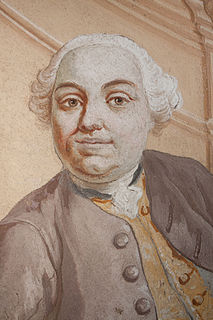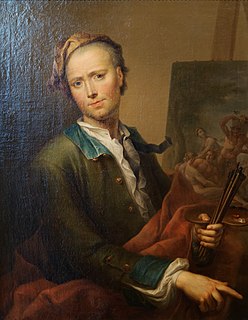


Franz Xaver Karl Palko (3 March 1724, Breslau - c. 1767, Prague) was a Silesian painter; known primarily for religious scenes, although he also did portraits and engravings.



Franz Xaver Karl Palko (3 March 1724, Breslau - c. 1767, Prague) was a Silesian painter; known primarily for religious scenes, although he also did portraits and engravings.
He was the son of a painter named Anton Palko (died 1754), about whom little is known. he began his studies at home, then went to Vienna, where he studied at the Academy of Fine Arts. In the 1740s, he was enrolled at the Accademia di Belle Arti di Venezia and came under the influence of Giuseppe Crespi. After returning, he worked in Bratislava, Kroměříž and Brno; finally settling in Dresden, where he painted frescoes depicting the life of Saint John of Nepomuk.
In 1752, he was appointed a court painter for the Electorate of Saxony, but moved on to Prague before a year was over, having received a commission from the Society of Jesus to paint frescoes at St. Nicholas Church. However, the Painter's Guild protested, noting that he was neither a guild member nor a citizen of Prague and was therefore undesirable. The following year, a Magistrate ruled that he could finish his work, on the grounds that being a court painter was equivalent to guild membership. [1]
He never became a citizen of Prague, but stayed there for many years. Most of his works appear to have been frescoes or altarpieces. At some point, he was married, as there are baptismal records for a son, Jan Xaver, dating from 1756. The mother's name is given as Marie Anna Bursch, from Saxony. [1]
Exact information regarding his death is not available. He apparently died in Prague in 1767, although other sources indicate that he moved to Munich in hopes of becoming a court painter for the Electorate of Bavaria, but was unsuccessful and died there, in poverty, in 1770. [2]
His brother, Franz Anton Palko was also a well-known painter.

Giovanni Battista Tiepolo, also known as GiambattistaTiepolo, was an Italian painter and printmaker from the Republic of Venice who painted in the Rococo style, considered an important member of the 18th-century Venetian school. He was prolific, and worked not only in Italy, but also in Germany and Spain.

The Academy of Fine Arts Vienna is a public art school in Vienna, Austria.

Franz Xaver Winterhalter was a German painter and lithographer, known for his flattering portraits of royalty and upper-class society in the mid-19th century. His name has become associated with fashionable court portraiture. Among his best known works are Empress Eugénie Surrounded by her Ladies in Waiting (1855) and the portraits he made of Empress Elisabeth of Austria (1865).

Jan Jakub Quirin Jahn was a Czech painter and art historian.

Karel Škréta Šotnovský ze Závořic was a Czech portrait painter who worked in the Baroque style. He lived through the Thirty Years' War which caused him some hardships as a Protestant which led him to leave Prague for Saxony then Italy.
Events from the year 1763 in art.
The decade of the 1410s in art involved some significant events.

Johann Baptist von Lampi the Elder was an Austrian-Italian historical and portrait painter. He settled in the Russian Empire after the third and final partition of Poland, enticed by an extremely generous offer from the Tsar.

Johann Jakob Zeiller was an Austrian painter.
Josef Kramolín was a Czech Jesuit brother and painter. He primarily painted religious-themed frescoes.
Jan Kryštof Liška was a Czech Baroque painter. His works mainly included altarpieces and frescoes.

Karel Svoboda was a Czech/Austrian painter, primarily of historical scenes, which are notable for their accurate detail. He worked in Prague and Vienna.

Johann Lucas Kracker, also Jan Lukáš Kracker or János Lukács Kracker was an Austrian-Czech painter of the late Baroque period. His work consisted mostly of ceiling or wall frescoes and altarpieces.

Georg Anton Urlaub was a Baroque painter from Franconia. He was associated for part of his career with the court of the prince bishop of Würzburg and painted portraits and also many frescoes and altarpieces for churches in Lower Franconia.

Walther Franz Xaver Anton, Prince of Dietrichstein, was a German prince member of the House of Dietrichstein, 5th Prince (Fürst) of Dietrichstein zu Nikolsburg, Princely Count of Tarasp, Baron (Freiherr) of Hollenburg, Finkenstein and Thalberg.

Wilhelm Kandler was a German Bohemian painter, illustrator, engraver and amateur essayist.

Anton Kern or Körne was a Bohemian-born German painter; primarily of religious and historical scenes.

Franz Christoph Janneck was an Austrian painter in the Baroque style. He specialized in genre scenes, often with mythological themes, as well as some portraits, landscapes and religious works.

Jan de Herdt, in Italy also called Il fiammingo was a Flemish painter and draughtsman. After training in Antwerp, he spent his entire career abroad, first in Northern Italy and later in Vienna and other cities in central Europe. He was mainly a portrait artist but also painted genre scenes as well as religious, mythological and allegorical subjects. He was part of a network of Flemish and Dutch painters working for the court, aristocracy and ecclesiastical institutions of central Europe.

Jacob Carl Stauder was a Swiss-German painter in the Baroque style.
![]() Media related to František Xaver Palko at Wikimedia Commons
Media related to František Xaver Palko at Wikimedia Commons